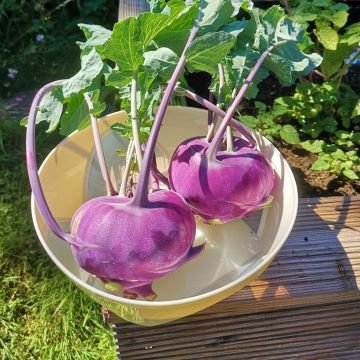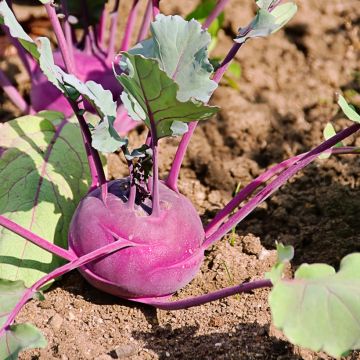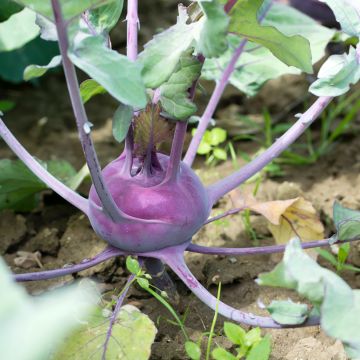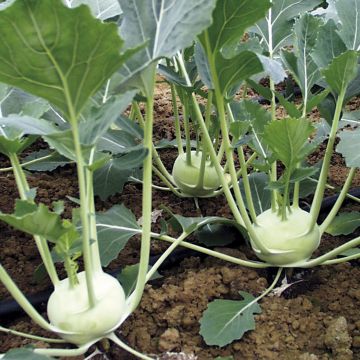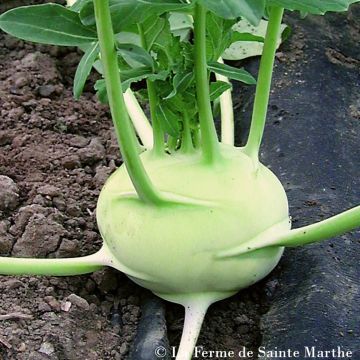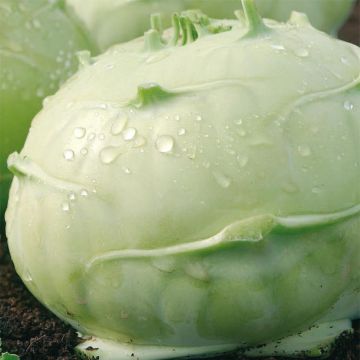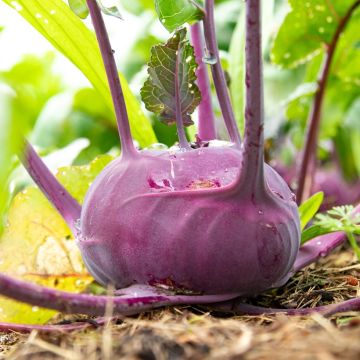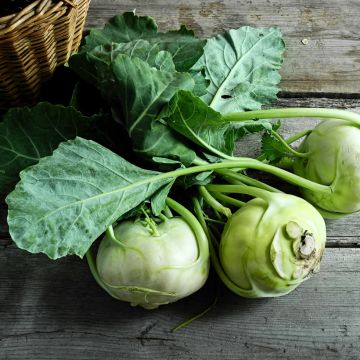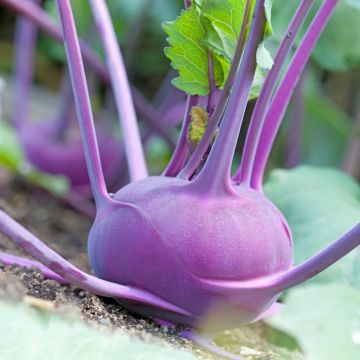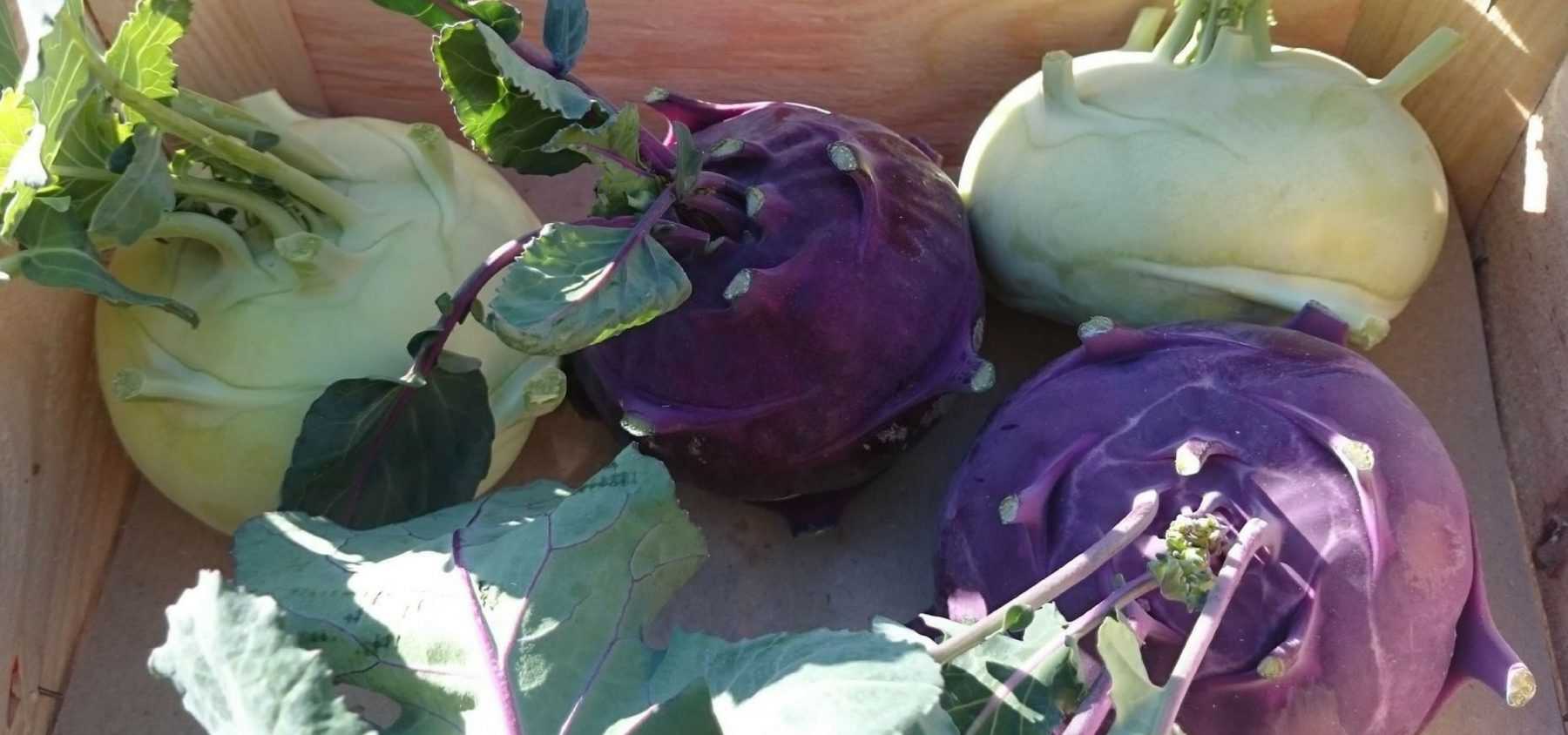
Growing Kohlrabi Successfully
All our tips for successful vegetable gardening
Contents
The kohlrabi is a variety of cabbage, grown in vegetable gardens for its swollen stems forming beautiful white, celadon green or purple bulbs. This heritage vegetable, which fell out of favour after the war, much like Jerusalem artichokes and swedes, is actually very easy to grow. It offers a fine, sweet and crunchy flesh reminiscent of radish, chestnut and turnip. Low in calories and packed with fibre, vitamins and minerals, it has numerous health benefits. Today, this plump little bulb is making a grand comeback in our vegetable gardens and on our plates! And rightly so, as this somewhat forgotten cabbage is full of qualities, both in terms of flavour and nutrition, and can be enjoyed both cooked and raw. It is sown in spring, grows quickly and requires almost no care. Its colourful and flavoursome bulbs are harvested from June to November. Discover how to sow and grow, as well as harvest and enjoy this cabbage that’s far less demanding than most other cabbages!
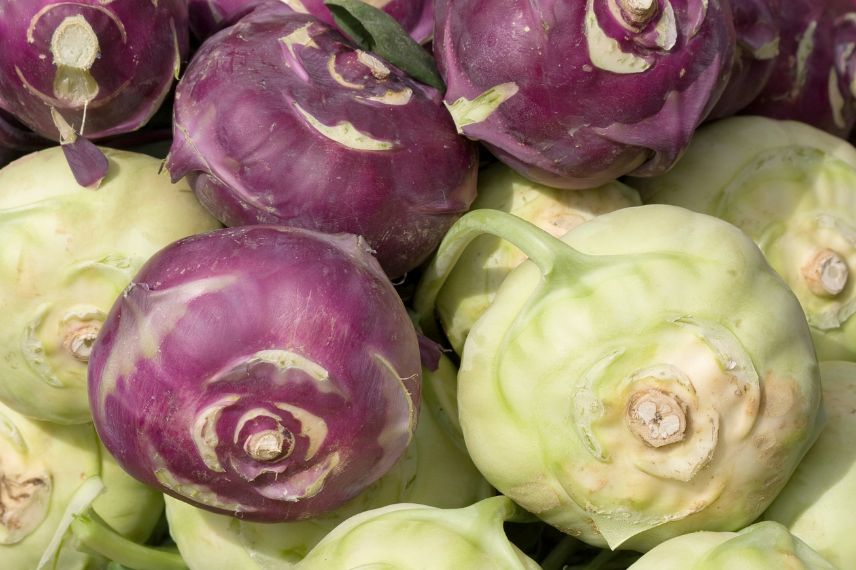
Kohlrabi: A Cabbage Like No Other
The kohlrabi (Latin name brassica oleracea var. gongylodes) is a small but flavoursome cruciferous vegetable, belonging to the extensive Brassicaceae family (formerly Cruciferae) alongside headed cabbages, cauliflowers, broccoli, and Brussels sprouts. It’s sometimes called Kohlrabi, Siam cabbage, Siam ball, colrave, or even cabbage-apple. This rather unusual-looking vegetable originates from Europe. Associated with the Second World War and food shortages, when it replaced potatoes requisitioned by the Germans, much like Jerusalem artichokes and swedes, it fell out of favour for decades. While widely consumed in Central Europe since the Middle Ages and in Asia, it lost popularity here after the Occupation. Today, it’s reclaiming its place in our vegetable gardens and regaining culinary status in some Michelin-starred kitchens.
Kohlrabi distinguishes itself from its cousins through its growth pattern. The fleshy stem, instead of growing upright like other cabbages, remains underground where it swells to form a white, pale green or purple ball 6-20 cm in diameter above soil level. From this swollen stem emerge large blue-green leaves with serrated edges and long petioles. Arranged in a spiral around the bulb, they give the plant a satellite-like appearance. Each bulb weighs between 200-300 grams when mature. The plant grows 30-40 cm tall and about 25 cm wide. These bulbs are tender and flavoursome with non-woody flesh. Kohlrabi is a biennial plant grown as an annual.
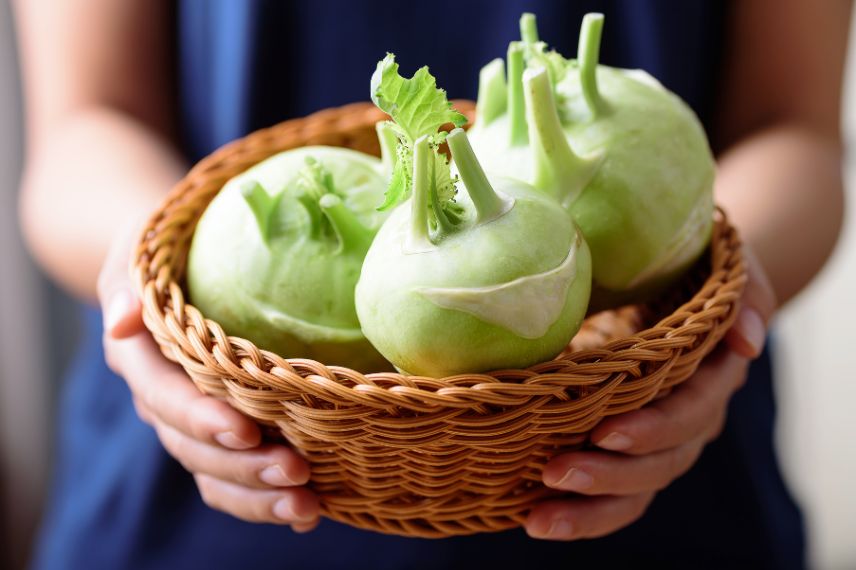
The Different Varieties of Kohlrabi
To our greatest delight, kohlrabi comes in several beautiful varieties, some of which are early. Depending on the harvest period, kohlrabi is classified as early or mid-season. We recommend the following varieties:
- The ‘Early White Vienna’ Kohlrabi: a very early variety with rapid growth, producing lovely white bulbs as early as June, tender and flavoursome.
- The ‘Superschmelz’ Kohlrabi: produces enormous yet tasty pale green-skinned bulbs, each weighing up to 10 kg!
- The ‘Azur Star’ Kohlrabi: an early and spectacular variety yielding striking purple bulbs from June. It is resistant to bolting.
- The ‘Blaro Violet BIO’ Kohlrabi: surprising because its violet skin reveals white flesh, full of flavour. Slightly later than white kohlrabi, it is harvested from July.
- The ‘Lanro White BIO’ Kohlrabi: produces beautiful white bulbs tinged with soft green. Early and bolt-resistant.
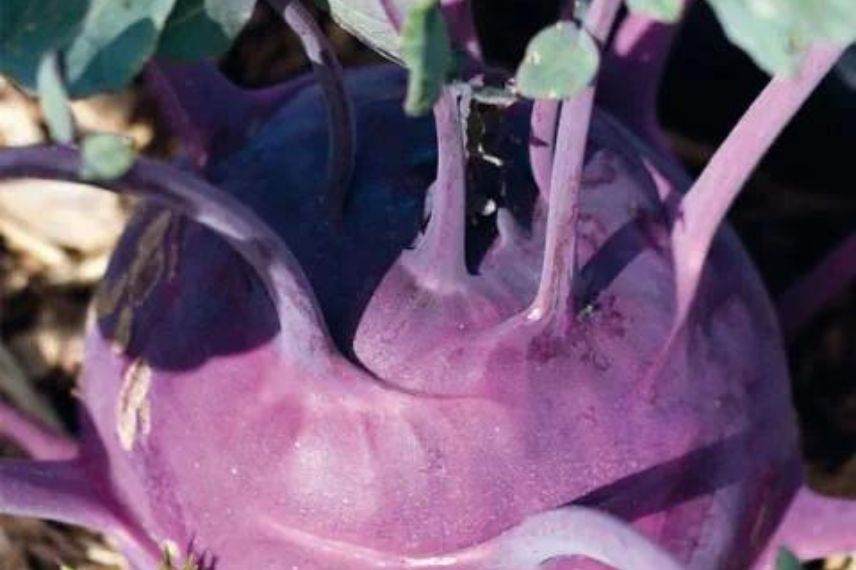
‘Azur Star’ Kohlrabi
Discover other Kohl rabi seeds
View all →Available in 1 sizes
Available in 1 sizes
Available in 1 sizes
Available in 1 sizes
Available in 1 sizes
Available in 1 sizes
Available in 1 sizes
Available in 1 sizes
Available in 1 sizes
Available in 1 sizes
When and how to sow kohlrabi?
Kohlrabi can be sown over a long period, from March to mid-July, depending on the variety. You can sow every fortnight until mid-summer to stagger the harvests.
Direct sowing in situ is possible, but preparing seedlings for transplanting is the most common method. Once well-developed, the plants are moved to their final position in the vegetable garden from mid-April to late August. They should be planted in warm, well-prepared soil: weeded, loosened with a spade or broadfork, then raked with a rake to create a fine tilth.
Preparing seedlings under cover:
- Fill pots or a seed tray with seed compost
- Sow the seeds 1 to 2 cm deep
- Cover lightly with compost or vermiculite
- Water gently with a fine spray, avoiding waterlogging
- Keep warm and in good light, at a minimum temperature of 7°C and maximum of 30°C
- Germination usually takes 5 to 14 days
- Thin out, keeping only the strongest seedlings
- When they have at least 4 or 5 leaves, transplant them to their final position outdoors once the risk of frost has passed
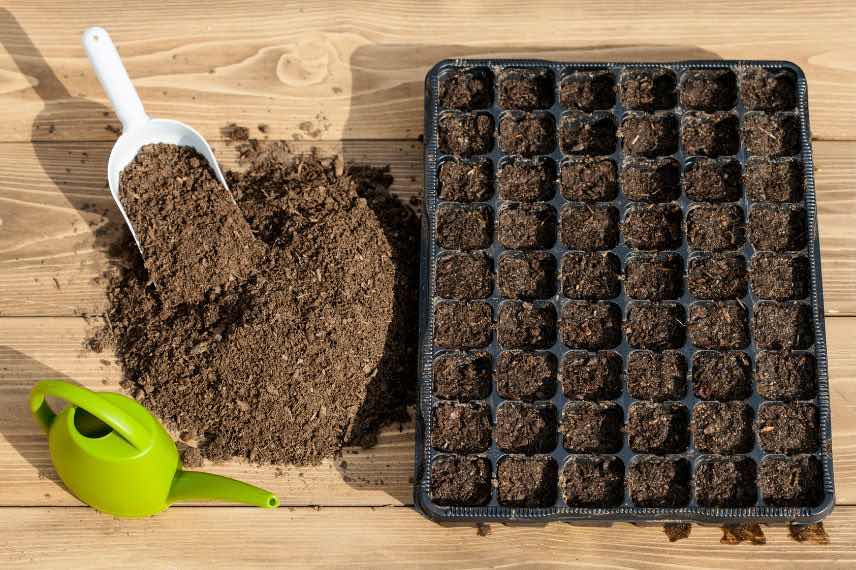
Direct sowing outdoors:
You can sow directly from April to August, in situ or in a nursery bed, once the risk of frost has passed, in well-crumbled, warmed and loosened soil.
- Make drills 1 to 2 cm deep, spaced about 30 cm apart
- Sow the seeds in rows every 3 cm and cover with a fine layer of soil
- Firm down and water gently to avoid displacing the seeds
- Keep the soil moist until germination
- Once the plants are well-developed, thin them out, leaving one plant every 25-30 cm
When and how to plant kohlrabi?
Kohlrabi plants should be planted in the garden from mid-April to late August. Before planting, the soil should be sufficiently warmed up, properly amended and finely worked. Kohlrabi thrives in cool, deep and well-fertilised soils. Like all cabbages, kohlrabi is a heavy feeder and requires good base fertilisation and regular moisture. In autumn, remember to amend the soil with an application of mature compost, spreading about 3 kg per m2. If you skip this step, be sure to add a good handful of well-rotted compost to each plant when planting. Seedlings should be transplanted at intervals of 25 to 30 cm in furrows one centimetre deep. Plan for about 9 to 10 plants per m² and place them in full sun or light shade.
- Loosen the soil well
- Dig a hole matching the size of the root ball
- Plant your seedlings up to the first true leaves
- Cover with soil
- Firm down and water to keep the soil moist
- Water regularly to help the plants establish
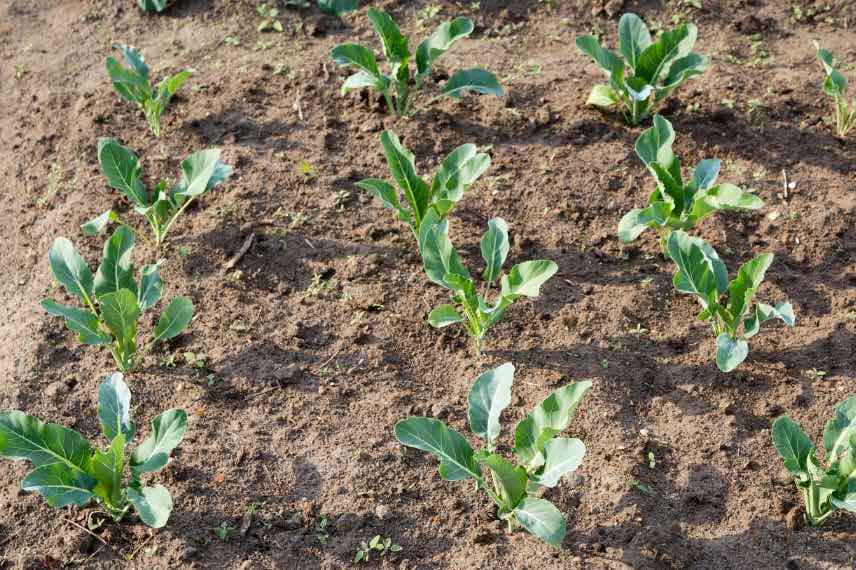
How to care for kohlrabi?
Low-maintenance, kohlrabi still requires some care during the growing season:
- Water regularly but avoid overwatering, especially during dry springs or heatwaves
- Earth up until mulching is applied to help the kohlrabi establish firmly and allow the bulb to develop properly at soil level
- Hoe regularly
- Mulch (with grass clippings, dead leaves) as kohlrabi prefers soil that stays cool in summer, reducing the need for watering
- Protect the bulbs: though it can withstand light frosts, in regions with early winters, thick mulching is recommended from October onwards.
Harvesting kohlrabi
Kohlrabi is harvested from early July to early November when the bulbs reach 7 to 8 cm in diameter. Harvesting typically occurs around 75 days, or two to three months after sowing. They are picked as needed by simply pulling them up. Don’t wait too long to harvest them, as the stem quickly becomes fibrous.
Once harvested, these root vegetables can be stored for several days in the fridge’s vegetable drawer or for several months in a dark, dry cellar or kept in dry sand. They also freeze very well after being blanched for 5 minutes in salted boiling water.
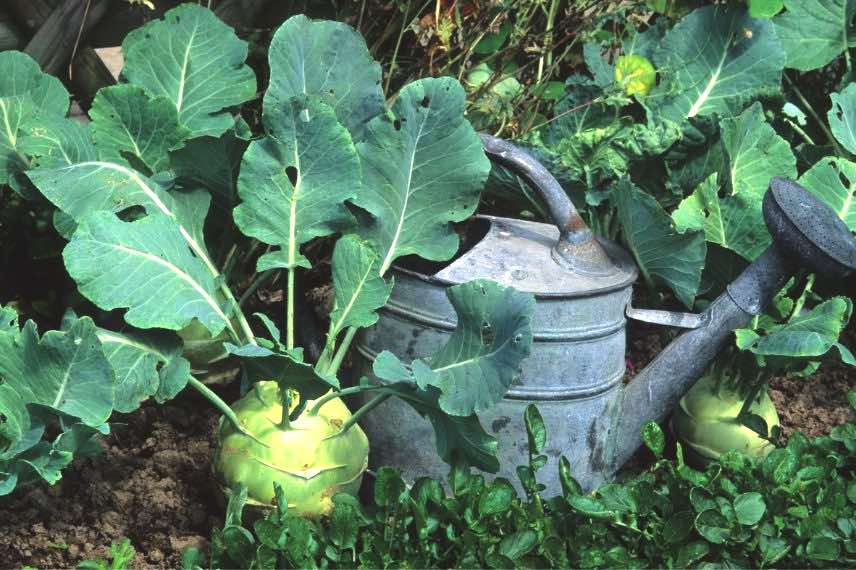
How to eat kohlrabi?
Kohlrabi can be enjoyed both raw and cooked. Grated or thinly sliced with a mandoline, boiled or steamed, in soups, stir-fries, purées, or gratins with béchamel sauce, or even candied with honey like turnips, in salads, or as carpaccio, or simply dipped in salt like radishes, kohlrabi lends itself to countless recipes. Low in calories and rich in vitamins C and B3 as well as fibre, it would be a shame to miss out on its many benefits and its subtle nutty flavour! And once cooked, its leaves can be eaten like spinach.
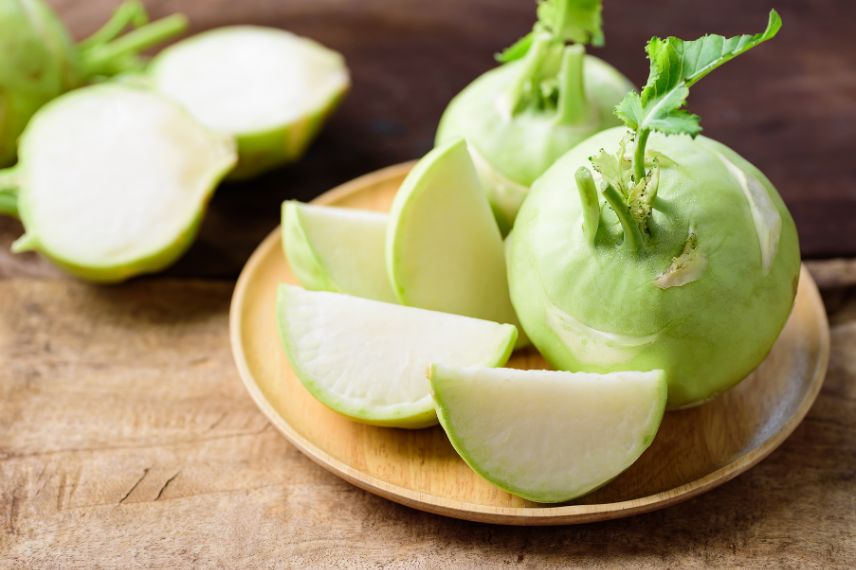
Pests and Diseases of Kohlrabi
Although hardy like all cabbages, kohlrabi is susceptible to certain diseases and pests. Against flea beetles in particular, we recommend using insect-proof netting or forcing covers to protect your plants from their appetite, and to read our advice on controlling flea beetles.
It is also highly attractive to slugs and snails. Discover our tips for effectively and naturally controlling these invaders. As a preventative measure, consider planting beneficial flowers nearby such as nasturtiums and maintain a crop rotation of at least 5 years between brassica plantings.
→ Learn more in our advice sheet: Cabbage diseases and pests
To go further
- Discover all our secrets for successful cabbage sowing in our guide
- Find more tips for growing cabbages successfully on our blog!
- Explore our wide range of varieties in our cabbage collection
- Subscribe!
- Contents


































